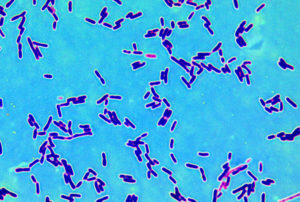 There has been a lot of discussion in the last few years of our gut bacteria (hundreds of species), the microbiome (the community of microbes living within and on a person (gut, nasal cavities, mouth, sinuses, etc.), probiotics, the finding of a link between bacteria and some chronic diseases, and how the modern lifestyle and antibiotics are wiping out our beneficial gut microbes. I am frequently asked how one can improve or nurture the beneficial bacteria in our bodies.
There has been a lot of discussion in the last few years of our gut bacteria (hundreds of species), the microbiome (the community of microbes living within and on a person (gut, nasal cavities, mouth, sinuses, etc.), probiotics, the finding of a link between bacteria and some chronic diseases, and how the modern lifestyle and antibiotics are wiping out our beneficial gut microbes. I am frequently asked how one can improve or nurture the beneficial bacteria in our bodies.
While no one knows what exactly is the "best" or "healthiest" microbial composition of the gut, it does look like a diversity of bacteria is best (may make you healthier and more able to resist diseases). Research also suggests that the diversity and balance of bacteria living in the body can be changed and improved, and changes can occur very quickly. And that the microbial communities fluctuate for various reasons (illness, diet,etc.). Diet seems to be key to the health of your gut microbial community. Prebiotics feed the beneficial bacteria in the gut, probiotics are live beneficial bacteria, and synbiotics are a combination of prebiotics and probiotics. But don't despair - you can improve your gut microbial community starting now. The following are some practical tips, based on what scientific research currently knows.
SOME STEPS TO FEED AND NURTURE YOUR GUT MICROBES:
Eat a wide variety of foods, especially whole foods that are unprocessed or as minimally processed as possible. Eat everything in moderation.
Eat a lot of plant based foods: fruits, vegetables, whole grains, seeds, nuts, and legumes. Think of Michael Pollan's advice: "Eat food. Not too much. Mostly plants."
Eat more washed and raw fruits and vegetables (lots of bacteria and fiber to feed and nurture the bacteria). Some every day would be good.
Eat more soluble and insoluble types of fiber, and increase how many servings you eat every day. A variety of fiber foods every day, and several servings at each meal, is best. Think fruits, vegetables, whole grains, legumes, nuts, seeds. (See How Much Dietary Fiber Should We Eat? - also has a chart with high fiber foods, and Recent Studies Show Benefits of Dietary Fiber)
Eat as many organic foods as possible. There is much we don't yet know, and pesticides are like antibiotics - they kill off microbes, both good and bad. Somehow I think that lowering the levels in your body of pesticides (as measured in blood and urine) can only be beneficial. Also, organic foods don't contain added antibiotics and hormones. (Eat Organic Foods to Lower Pesticide Exposures). But even if you can't or won't eat organic foods, it is still better to eat non-organic fruits, vegetables, and whole grains than to not eat them.
Eat some fermented foods such as kimchi and sauerkraut (they contain live bacteria), kefir, and yogurts with live bacteria. Eat other bacteria containing foods such as cheeses, and again a variety is best (different cheeses have different bacteria).
Try to avoid or eat less of mass-produced highly processed foods, fast-foods, preservatives, colors and dyes, additives, partially hydrogenated oils, and high-fructose corn syrup. Read all ingredient lists on labels, and even try to avoid as much as possible "natural flavors" (these are chemicals concocted in a lab and unnecessary). Even emulsifiers (which are very hard to avoid) are linked to inflammation and effects on gut bacteria.
Avoid the use of triclosan or other "sanitizers" in soaps and personal care products (e.g., deodorants). Triclosan promotes antibiotic resistance and also kills off beneficial bacteria. Wash with ordinary soap and water.
Avoid unnecessary antibiotics (antibiotics kill off bacteria, including beneficial bacteria).
Vaginal births are best - microbes from the birth canal populate the baby as it is being born. If one has a cesarean section, then one can immediately take a swab of microbes from the mother's vagina (e.g., using sterile gauze cloth) and swab it over the newborn baby. (See post discussing this research by Maria Gloria Dominguez Bello )
Breastfeeding is best - breastfeeding provides lots of beneficial microbes and oligosaccharides that appear to enrich good bacteria in the baby’s gut.
Live on a farm, or try to have a pet or two. Having pets, especially in the first year of life, ups exposure to bacteria to help develop and strengthen the immune system, and prevent allergies. Pets such as dogs and cat expose humans to lots of bacteria.
Get regular exercise or physical activity. Professional athletes have more diverse gut bacterial community (considered beneficial) than sedentary people.
Can consider taking probiotics - whether in foods or supplements. They are generally considered beneficial, but not well studied, so much is unknown. The supplements are unregulated, and the ones available in stores may not be those that are most commonly found in healthy individuals. Research the specific bacteria before taking any supplements. Researchers themselves tend to stay away from probiotic supplements and focus on eating a variety of all the foods mentioned above (fruits, vegetables, whole grains, seeds, nuts, legumes, fermented foods) to feed and nurture beneficial bacteria.
 Every time you inhale, you suck in thousands of microbes. And depending on where you live, the microbes will vary. From Wired:
Every time you inhale, you suck in thousands of microbes. And depending on where you live, the microbes will vary. From Wired: Clasdosporium is a genus of fungi including some of the most common indoor and outdoor molds. Credit: Wikipedia.
Clasdosporium is a genus of fungi including some of the most common indoor and outdoor molds. Credit: Wikipedia.
 This nice general summary of what scientists know about the microbial community within us was just published by a division of the NIH (National Institutes of Health). Very simple and basic. From the National Institute of General Medical Sciences (NIGMS):
This nice general summary of what scientists know about the microbial community within us was just published by a division of the NIH (National Institutes of Health). Very simple and basic. From the National Institute of General Medical Sciences (NIGMS): A
A  Another study finding negative effects of air pollution - this time high levels of traffic-related air pollution is linked to slower cognitive development among 7 to 10 year old children in Barcelona, Spain. From Science Daily:
Another study finding negative effects of air pollution - this time high levels of traffic-related air pollution is linked to slower cognitive development among 7 to 10 year old children in Barcelona, Spain. From Science Daily: Long-term air pollution can cause damage to the brain: covert brain infarcts ("silent strokes") and smaller brain volume (equal to one year of brain aging).
Long-term air pollution can cause damage to the brain: covert brain infarcts ("silent strokes") and smaller brain volume (equal to one year of brain aging). The statements in this editorial may be obvious to many, but it is nicely written and needs to be said. Basically it says that exercise will not help you overcome the ill effects of a poor diet. I agree with what was said, but felt that what was missing was mention that a poor diet also has negative effects on the microbiome (the community of microbes living within the person) - which we know is linked to health problems.
The statements in this editorial may be obvious to many, but it is nicely written and needs to be said. Basically it says that exercise will not help you overcome the ill effects of a poor diet. I agree with what was said, but felt that what was missing was mention that a poor diet also has negative effects on the microbiome (the community of microbes living within the person) - which we know is linked to health problems.